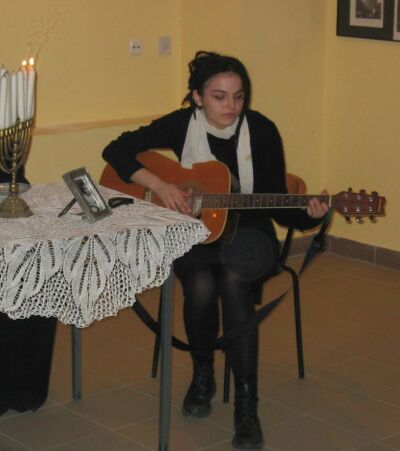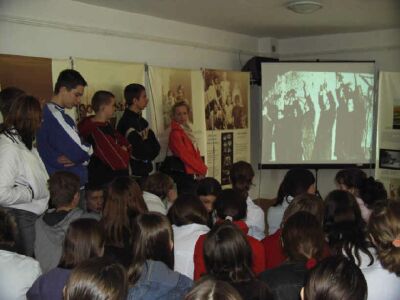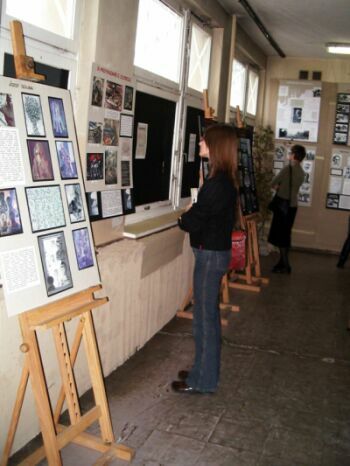



The exhibition "Anne Frank- a history for today" was visited by more than 10 millions of people in over 30 countries. This exhibition is the most well-known educational exhibition on holocaust and human rights issues in the world.
The exhibition was created in the early 90ies in order to enable the broader audience to learn about Anne Frank and her life. For those, who were not able to come to Amsterdam to see the secret annex for themselves, in which Anne with her family and friends were hiding from the Nazis between 1942-1944. This is the reason why such a travelling exhibition that tours over the world was created.
We learn about Anne Frank's life and the time in the history by getting to know the historical events of that time and also by reflecting on them and the issue of tolerance. Anne had written a lot in her diary about tolerance, and her voice is still to be heard in the exhibition- the voice that makes us to reflect and consider these issues in our life. The main goal of the exhibition is to wake up in the need of critical thinking and to recognise in our daily life certain events. The remembrance of the past and linking it to the current time this is a lesson, given us by Anne Frank over and over again.
The exhibition in Poland
Since 1993 the exhibition "Anna Frank in the World, 1929-1944" tours in Poland. In 1997 was cerated a new version of the exhibition entitled "Anna Frank - a history for today". Until now it has been presented in more then 20 cities. The new project of the Anne Frank House in Poland aims to implement the peer education- the educational concept, in which the young people are learning from each other and teaching their peers. The main goal is to encourage in the highest level, the youth that are participating, not only guiding and working with the exhibition; rather, to make preparations to the project in their schools (starting with transportation, setting up and down the exhibition, and ending with preparation and leading of supportive events that will be realised together with the exhibition).
The exhibition "Anne Frank- a history for today" has been touring in Poland since 1997 and has been shown in over 30 places. Since 2004 the exhibition became a part of the school-tour and came to various schools all over the country. The students became exhibition guides and work with the school-groups in the exhibition, explaining it and moderating discussions with their peers. Moreover they themselves work with the topics, the exhibition deals with and organize activities that support the output of the exhibition project. The most important aim of the project is the engagement and active participation in discussion and working with the history of Holocaust and tolerance issues together with their peers. In 2004/2005 the project is financially supported by NCDO (Dutch Committee for International Cooperation and Sustainable Development).
Campus tour of the exhibition in 2004/2005
The exhibition "Anne Frank- a history for today" was previously presented in the community centres, cultural houses and museums. Since it was created in a way to enable working with the youth aged 13-18, it started to be very popular among school-groups.
In the beginning it was the exhibition that needed to attract and draw up the students, as they were the ones who had to come to places of its presentation to see it. This was one of the reasons why the exhibition had difficulties attracting students, as they were the target group. The exhibition campus tour changed this problem, as now the exhibition arrived to the students by being set up in their schools.
The main goal of the travelling exhibition "Anne Frank- a history for today" is the encouragement by thinking about the values and themes like: tolerance, regard towards cultural variety, human rights and democracy in the present times. This is achieved by telling the history of Anne Frank from the perspective of the Frank Family and linking it with the history of the holocaust told by the survivours and eye-witnesses. The exhibition contains several elements that challenge the visitors into thinking about similarities and differences between the past events and the current incidents. In many cases these past events can be linked to the present burning issues.
Peer education
The main role in the school tour of the exhibition caters to the students. They will be involved in bringing the exhibition to their school as well as the organisation of the whole project. The students of various high-schools will become the exhibition guides and will work in their peer groups in the exhibition. This has been extremely successful at locations where students were very much involved in the organisation of the project.

The students guide their peers through the exhibition
The training will be led by an employee who is specialised in peer education from the Anne Frank House in Amsterdam. During the 2-day workshop, the student will be prepared to guiding and working with the peer-groups in the exhibition. The youth will learn the historical background of the events, presented on the exhibition and will get to know how to use certain elements of the exhibition during guiding and the ways of group-working with their peers.

Students learn to work with the peer- groups in the exhibition
For years we gather great experiences from working with young volunteers that guide their peers through the Anne Frank exhibition. As in the front of the groups stands not the professional but a teenager- that speaks their language and is "one of them". The motto of the Campus tour of the Anne Frank exhibition is Peer-to-peer. Thanks to this educational concept the young guides will have an easy contact with their peer group and will be able to create a dialogue with them in the exhibition, share and exchange the information, thoughts and experiences. The exhibition builds a broader context and provokes to thinking over certain issues presented on the panels. And for the guide himself the exhibition becomes an important life experience.
The guiding through the exhibition is not limited to visiting and seeing the panels and discussions in the group. The important element of guiding is also watching the film "the short life of Anne Frank", that summerises the exhibition, the discussions and leads to conclusions.

During the guide training the students create posters connected with issues
the exhibition deals with
The exhibition itself is an important educational tool, but in order to achieve maximal effects from its presentation, one needs to use all the possibilities that the appearance of the exhibition in the school and in the school-life gives. That is why we encourage the organisation of the supportive events at schools in order to reinforce and bring out its aims. The students will spend between 30-90 minutes in the exhibition itself. The teachers and educators may due to the others projects in the school during the classes and in the free-time enable the students to stay in touch with the topics, that the exhibition raises a longer time, though. Every school (and every teacher in each school) will have her/his own ideas for organising the supportive educational events, connected to the themes linked with those of the exhibition on Anne Frank and holocaust. One can discuss these topics situating them in various contexts: for example:
history of WWII
history of the Holocaust
fight against racism and discrimination
20th century literature and art
intercultural education
citizenship involvement
Jewish culture
present European and worlds events

Young people learn the history of Holocaust and discuss the up-to-date issues
connected with the tolerance
From our experience we have learned that the most efficient results are given by the supportive educational activities that link various contexts and plans. In this way both the students and the teachers that are involved and interested in various topics may cooperate together in common activities. This will enable the students to face the themes raised by the exhibition, for the longer time, from various points of views and on more levels and for a much longer time (then e.g. the Polish or history teachers have).
The students with the support and help of their teachers and educators will prepare and lead the programme of events that support the exhibition. It is up to them, what it will be like- and the realisation of it will not only depend on them and their engagement, but also on support and encouragement of the students by their teachers. One can for example organise:
theatre- play/ pantomime/ happening (on the topics raised in the exhibition);
meetings with eye-witnesses and holocaust and war survivors, members of various national, ethnical
and religious groups;
poetry evening with the motto of tolerance;

discussion panel with invited guests;
mini- film- festival of films on Jewish topics;
excursions "following the traces of" (national or ethnical minority etc.);
special edition of school- newspaper/ radio programme/ documentary film on the project and
distributing them outside the school;

creating a website on holocaust, tolerance issues or human rights;
concert with the theme of fight against racism and discrimination;
art-workshops- and creating informational posters promoting the exhibition and the tolerance topics
contest for the piece of art promoting tolerance and fight with discrimination
